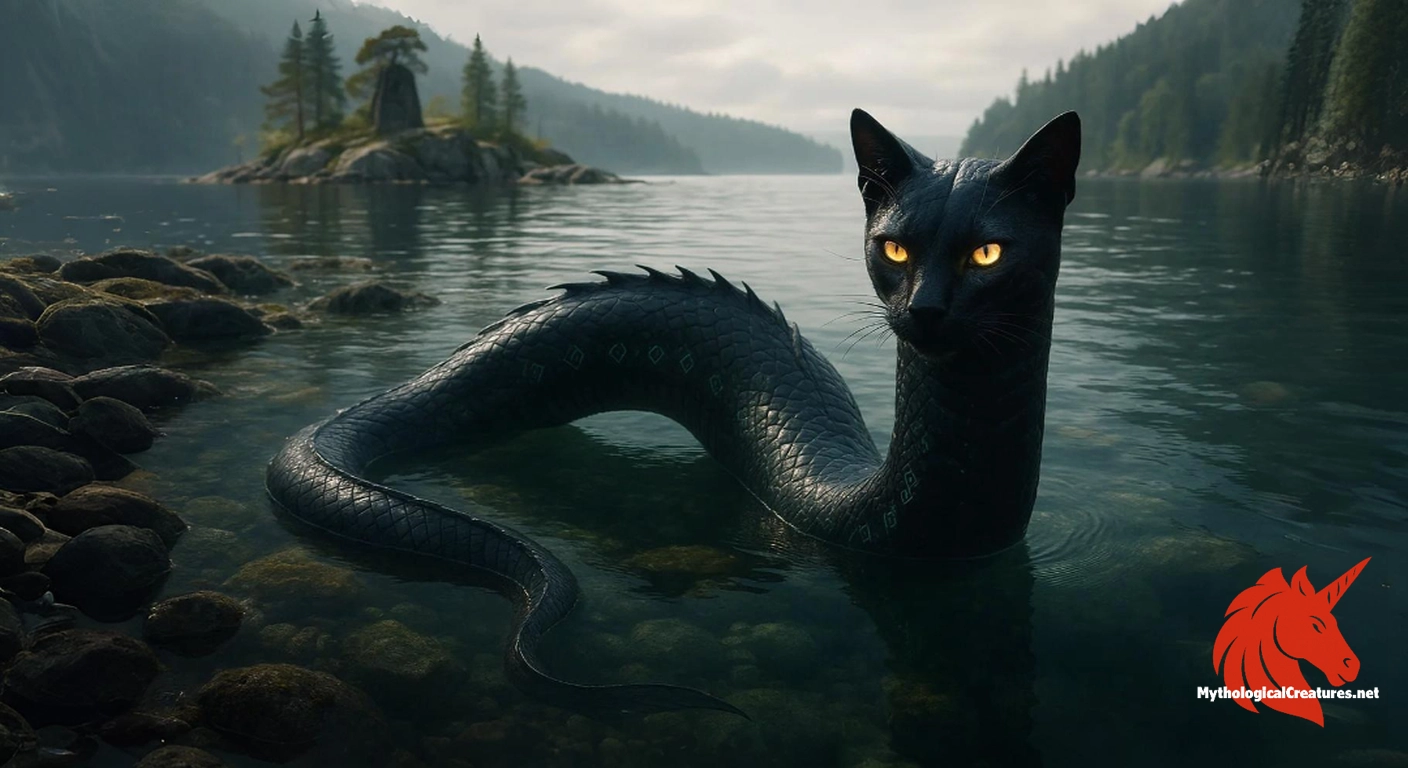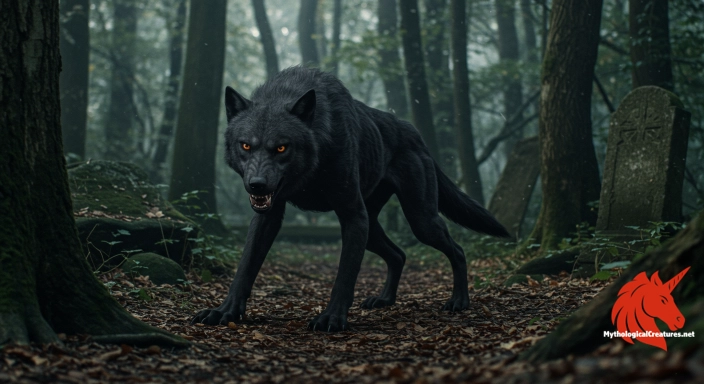Storsjöodjuret: Storsjöodjuret is a legendary lake monster from Swedish folklore, said to inhabit the deep waters of Lake Storsjön in Jämtland.

Storsjöodjuret
Storsjöodjuret - Storsjöodjuret is a key figure in Swedish folklore symbolising mystery and the unexplained phenomena of nature.
Origins & First Encounters
The legend of the Storsjöodjuret arises from the deep and enigmatic folklore of Jämtland, Sweden, and it has fascinated both locals and visitors for centuries. Its origins are embedded in a mix of ancient runic traditions and oral narratives, which have conveyed the mystery of a creature dwelling in the profound depths of Lake Storsjön. Early mentions of the beast in a 17th-century manuscript lend it an air of antiquity and mysticism. The tale recounts its confinement by a powerful figure whose magical interventions echo the era’s blend of superstition and ritual. Over time, its narrative absorbed local influences, with variations emerging that added layers of complexity and intrigue. The Storsjöodjuret is not simply a monster but a symbol of nature’s unfathomable power and the human desire to decode what lies beneath the surface. Its myth serves as a cultural mirror reflecting the fears, hopes, and creative impulses of the communities surrounding the lake. Today, it endures as a captivating emblem of Swedish myth, continuously reimagined by storytellers and believers alike.
Source Texts & Tale Variants
The primary textual evidence for the Storsjöodjuret is rooted in a manuscript from 1635, which sets the foundation for its mysterious reputation. This early document tells of the creature being magically bound within the lake by Kettil Runske, a detail that imbues the legend with a sense of arcane authority. Oral traditions flourished in the surrounding regions, allowing the tale to adapt and evolve over subsequent generations. Multiple variations emerged, some of which attribute the monster’s creation to the playful or cunning interventions of local trolls. These differing accounts enriched the creature’s mythology, leading to depictions that sometimes describe it with a cat-like head and at other times a more canine visage. As the 19th century arrived, eyewitness reports contributed fresh perspectives that both challenged and deepened the established lore. The interplay between written sources and folk retellings underscores the dynamic nature of this legend. Ultimately, the convergence of these narratives highlights the integral role of both historical texts and oral storytelling in sustaining the myth of the great lake monster.
Form & Powers
The physical description of the Storsjöodjuret is as variable as the legends themselves, often depicted as a creature that defies simple classification. Many accounts describe it as a massive, serpentine entity that meanders through the dark, cold waters of Lake Storsjön. Observers have noted an elongated body covered with scales that shimmer in dim light, evoking the eerie qualities of deep-water mysteries. In some local tales, the creature is said to possess a head reminiscent of a feline, complete with keen, piercing eyes and subtle whisker-like features that add a touch of otherworldly elegance. Other traditions, however, portray it with a more robust, dog-like head that suggests both strength and unpredictability. Descriptions often suggest that its body extends to unparalleled lengths, a fact that fuels both wonder and scepticism among those who have allegedly seen it. The combination of graceful curves with abrupt, rugged features gives the Storsjöodjuret a uniquely ambiguous presence. Such diverse portrayals reinforce its status as a creature born of myth, where nature’s splendor and terror are intertwined in its very form.
Regional Faces
The myth of the Storsjöodjuret is deeply rooted in the local landscape of Jämtland, yet its features are subject to notable regional variations across neighbouring Scandinavian communities. In the immediate vicinity of Lake Storsjön, local narratives imbue the beast with a dual nature, sometimes revered as a guardian of the waters and at other times feared as a portent of misfortune. Communities have adapted the legend to their own cultural and environmental contexts, resulting in a spectrum of descriptions that range from benevolent to menacing. In some areas, the creature is seen as a protector, whose mysterious presence maintains the natural order of the lake’s ecosystem. Elsewhere, more ominous versions prevail, warning of its unpredictable appearance during foul weather or at twilight. These regional adaptations reveal how communal identity and environmental peculiarities shape the myth. The blending of local folklore with historical accounts has ensured that the Storsjöodjuret remains a living part of regional heritage. As local storytellers continue to rework and embellish its narrative, the creature’s myth persists as a vibrant expression of the cultural diversity found throughout Scandinavia.
Cultural Parallels
The Storsjöodjuret holds a distinctive place within the broader spectrum of global lake monster myths, drawing intriguing parallels with other legendary cryptids. Much like the famed Loch Ness Monster of Scotland, it is enveloped in mystery and shrouded in an abundance of eyewitness accounts that span centuries. These comparisons illuminate common themes in folklore, such as the human fascination with the unknown depths and the natural world’s enigmatic giants. The creature parallels myths like Canada’s Ogopogo and even the serpentine figures encountered in Norse sagas, where the interplay of beauty and terror captivates the imagination. Its dual portrayal—with hints of both feline and canine features—resonates with a recurring motif found in many aquatic legends. Each cultural narrative frames these beasts as reflections of nature’s indomitable spirit and the eternal struggle between order and chaos. The shared elements between the legends suggest that such myths serve as a universal language, connecting communities through a common acknowledgement of life’s mysteries. In this way, the Storsjöodjuret not only reinforces Sweden’s rich mythological tradition but also contributes to a global tapestry of folklore that transcends geographical boundaries.
Legacy & Modern Evolution
Over the centuries, the Storsjöodjuret has evolved from a shadowy figure of ancient lore to a celebrated icon of Swedish cultural heritage. Its early mention in a 17th-century manuscript set the stage for a narrative that would capture the local imagination and endure through the ages. Eyewitness accounts that emerged in the 19th century added a tangible modern dimension to the myth, inviting both believers and sceptics to contemplate its existence. This creature has inspired a diverse array of artistic portrayals, ranging from traditional paintings to contemporary digital representations. Modern interpretations often depict the lake monster as both a symbol of the untamed natural world and an emblem of the mysterious forces that govern it. Local festivals and cultural events centred around its legend have helped to reinforce community bonds and promote tourism in the region. The integration of historical lore with modern media has allowed the Storsjöodjuret to remain relevant and continuously reinterpreted. Ultimately, its legacy is one of enduring wonder, bridging the gap between past and present and reminding us of the perennial allure of the unknown.
Interesting Fact
Some legends attribute the creature's creation to the mischievous tinkering of trolls, adding an extra layer of mythic intrigue to its mysterious legacy.
Quick Creature Info
Origin:
Features:
Associations:
Our Mythic Legendary Rating:

Habitat:
Physical Attributes:
Abilities:
Behavior:
Lore:
Related Creatures, Tales or Lore
References
Discover Another Mythical Legend You May Not Have Heard Of?
Uncover the mysteries of ancient folklore and expand your knowledge of legendary beings from cultures around the world.
Dare to Meet the Pricolici....
Mythical Disclaimer: The images and data on this site are derived from various historical and literary sources, but we have found that many myths often have multiple versions and interpretations across references, sometimes contradictory. As a result, these creature depictions are artistic interpretations—imaginative blends of folklore, legend, and a dash of AI guesswork. Because creature descriptions vary widely, our illustrations and accompanying information represent our best effort to honor mythology while bridging creative gaps. Enjoy these interpretations—just remember, we've done our best to respect the stories and validate available data, but in the realm of mythology, details often shift, imagination leads the way, and nothing is ever set in stone!
Curated by the Mythological Creatures Team (rev. May 2025)
